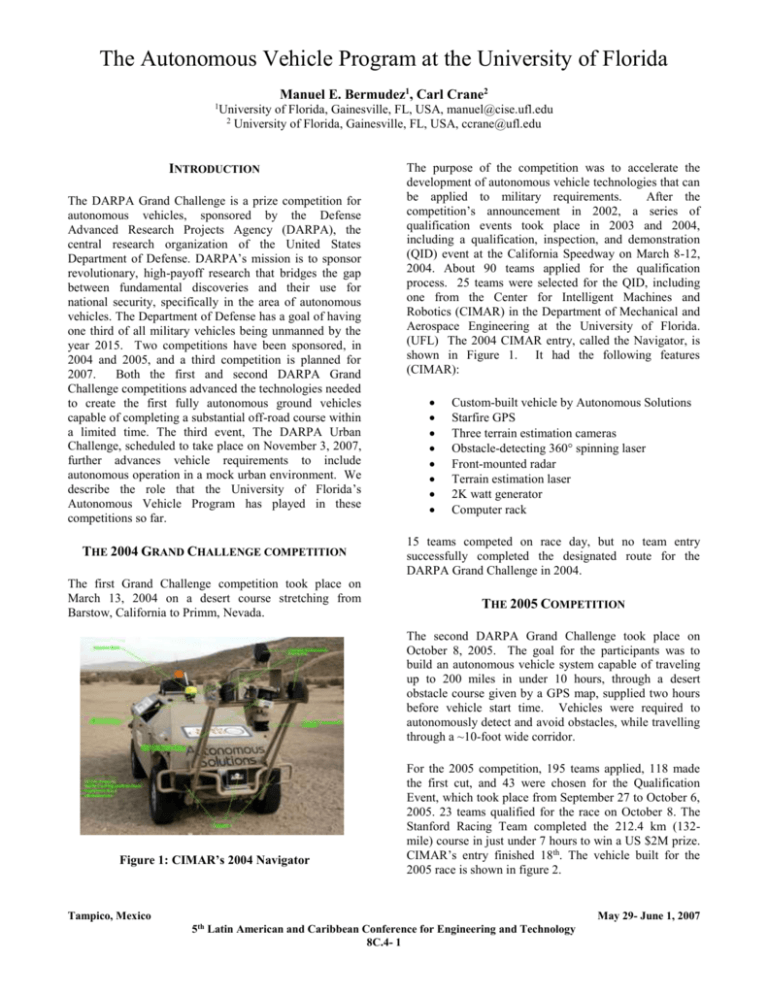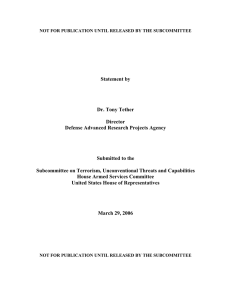p203
advertisement

The Autonomous Vehicle Program at the University of Florida Manuel E. Bermudez1, Carl Crane2 1 University of Florida, Gainesville, FL, USA, manuel@cise.ufl.edu 2 University of Florida, Gainesville, FL, USA, ccrane@ufl.edu INTRODUCTION The DARPA Grand Challenge is a prize competition for autonomous vehicles, sponsored by the Defense Advanced Research Projects Agency (DARPA), the central research organization of the United States Department of Defense. DARPA’s mission is to sponsor revolutionary, high-payoff research that bridges the gap between fundamental discoveries and their use for national security, specifically in the area of autonomous vehicles. The Department of Defense has a goal of having one third of all military vehicles being unmanned by the year 2015. Two competitions have been sponsored, in 2004 and 2005, and a third competition is planned for 2007. Both the first and second DARPA Grand Challenge competitions advanced the technologies needed to create the first fully autonomous ground vehicles capable of completing a substantial off-road course within a limited time. The third event, The DARPA Urban Challenge, scheduled to take place on November 3, 2007, further advances vehicle requirements to include autonomous operation in a mock urban environment. We describe the role that the University of Florida’s Autonomous Vehicle Program has played in these competitions so far. The purpose of the competition was to accelerate the development of autonomous vehicle technologies that can be applied to military requirements. After the competition’s announcement in 2002, a series of qualification events took place in 2003 and 2004, including a qualification, inspection, and demonstration (QID) event at the California Speedway on March 8-12, 2004. About 90 teams applied for the qualification process. 25 teams were selected for the QID, including one from the Center for Intelligent Machines and Robotics (CIMAR) in the Department of Mechanical and Aerospace Engineering at the University of Florida. (UFL) The 2004 CIMAR entry, called the Navigator, is shown in Figure 1. It had the following features (CIMAR): Custom-built vehicle by Autonomous Solutions Starfire GPS Three terrain estimation cameras Obstacle-detecting 360° spinning laser Front-mounted radar Terrain estimation laser 2K watt generator Computer rack THE 2004 GRAND CHALLENGE COMPETITION 15 teams competed on race day, but no team entry successfully completed the designated route for the DARPA Grand Challenge in 2004. The first Grand Challenge competition took place on March 13, 2004 on a desert course stretching from Barstow, California to Primm, Nevada. THE 2005 COMPETITION The second DARPA Grand Challenge took place on October 8, 2005. The goal for the participants was to build an autonomous vehicle system capable of traveling up to 200 miles in under 10 hours, through a desert obstacle course given by a GPS map, supplied two hours before vehicle start time. Vehicles were required to autonomously detect and avoid obstacles, while travelling through a ~10-foot wide corridor. Figure 1: CIMAR’s 2004 Navigator For the 2005 competition, 195 teams applied, 118 made the first cut, and 43 were chosen for the Qualification Event, which took place from September 27 to October 6, 2005. 23 teams qualified for the race on October 8. The Stanford Racing Team completed the 212.4 km (132mile) course in just under 7 hours to win a US $2M prize. CIMAR’s entry finished 18th. The vehicle built for the 2005 race is shown in figure 2. Tampico, Mexico May 29- June 1, 2007 5th Latin American and Caribbean Conference for Engineering and Technology 8C.4- 1 THE 2007 COMPETITION The 2007 Grand Challenge offers a prize of US $2M for the best autonomous SUV, capable of operating in an urban environment, with traffic, merging, passing, and parking capabilities. The vehicle must travel 60 miles in under 6 hrs, with a top speed of 30 mph. Vehicles must: Figure 2: CIMAR’s 2005 Navigator CIMAR’s 2005 Navigator had the following features: Rock crawler vehicle platform Transverse Honda engine/transaxle mounted longitudinally Locked transaxle that drives front and rear Detroit Locker differentials Hydraulic steering Two independent 24V alternator systems; 5600 W continuous power Air conditioned and vibration isolated electronics enclosure Obey traffic laws. Stay entirely within lane while turning corners. Stop within 1 meter of the stop line. Exhibit less than 10 sec. delay in enter an intersection once it is clear. Complete passing maneuver in 40 meters or les, maintaining an 8-meter safety buffer. Exhibit correct parking lot behavior with than 10 sec. excess delay. The organizers have winnowed the list of eighty-nine entrants down to fifty-three that will move on to the next stage. One of these 53 is CIMAR’s 2007 vehicle, named Gator Nation, shown in figure 4. The positioning and sensing system mapped all knowledge of terrain and obstacles onto a 60m x 60m traversability grid, with a grid resolution of 0.5m x 0.5m, as shown in figure 3, with the following characteristics: Positioning: Starfire GPS, Smiths Aerospace IMU. Obstacles: bumper height ladar, long range radar. Terrain: two stationary ladars, image processing. Implementation of sensor arbitration via traversability grid. Figure 4: CIMAR’s Gator Nation Site visits will take place in June and July to verify that the vehicles are safe and operable. Based on the site visits, DARPA will pick 30 semifinalists to take part in the National Qualification Event on October 21-31. On August 10, the agency will announce the 30 semifinalist teams, as well as the location chosen for the final contest on November 3, 2007, called the Urban Challenge. REFERENCES Figure 3: The Navigator’s sensing system DARPA, http://www.darpa.mil/grandchallenge/ CIMAR, http://cimar.mae.ufl.edu/grand_challenge/ UFL, http://www.ufl.edu Tampico, Mexico May 29- June 1, 2007 5th Latin American and Caribbean Conference for Engineering and Technology 8C.4- 2







